Description
The network access model in the enterprise campus has evolved significantly from basic user connectivity to an intelligent, powerful, and high-speed building block. Security, cloud, mobility, and the Internet of Things (IoT) in enterprise networks have been driving the network toward major innovations. Cisco® Catalyst® 9000 software and hardware have been designed to address these current and future demands.
Wireless technology is the industry’s new megatrend, and it presents a multidimensional challenge to enterprise IT organizations. This swiftly growing technology, with exponentially increasing numbers of mobile devices with high-performance demands, is rapidly changing the landscape of network infrastructure and its reliability. IT requires a reassessment of traditional network models and assembly of network designs that can respond with a broad set of evolutionary architectures. Stacking provides an opportunity to use a pay-as-you-grow model to meet these demands.
As the wired and wireless Gigabit evolution begins at the access layer, user and application demands will increase to high-speed, low-latency data switching for optimal performance. Cisco has built a system architecture to support such innovations. The new Cisco Catalyst 9000 switching family is the next generation in the legendary family of enterprise LAN access, aggregation, and core switches. Cisco Catalyst 9200 Series Switches extend the power of intent-based networking and hardware and software innovation to a broader set of deployments. Compared to the scale and feature richness of the Cisco Catalyst 9300 Series Switches, the 9200 Series switches focus on offering features for the midmarket and simple branch deployments. With its family pedigree, the Cisco Catalyst 9200 Series offers simplicity without compromise. It is secure, is always on, and provides IT simplicity. This white paper talks in detail about the benefits and architecture of Cisco StackWise®-160/80, which provides the always-on experience.
Introduction to StackWise-160/80
The StackWise-160/80 architecture allows stacking of up to eight switches in a ring topology to achieve a high density of stack bandwidth. The stacking architecture expands the switches’ form factor, switching capacity, port density, and redundancy as well as providing a single control plane. It also provides resiliency, scalability, and central management. The latest Cisco Catalyst 9200 Series Switches support StackWise-160, whereas the Cisco Catalyst 9200L models support StackWise-80. This technology is flexible, modular, and evolutionary, and it delivers Cisco IOS® XE feature capabilities with hardware acceleration to every port in the stack.
Cisco Catalyst 9200 Series Switches come in data, Power over Ethernet (PoE), and Multigigabit versions. Each version has 24-port and 48-port variants. The hardware design of each model is cost-effective to support different network capacity load and switching performance.
Up to a maximum of eight switches can be stacked together physically in a ring topology to form a single, unified, virtual stack system. A Cisco Catalyst 9200 Series Switch, when deployed in StackWise-160/80 mode, has been designed to deliver deterministic and nonblocking switching performance to a maximum port density of 448 ports with a distributed data plane, single control plane, and management plane. The switching performance delivers hardware-accelerated, integrated borderless network services such as PoE, PoE+, Quality of Service (QoS), Access Control Lists (ACLs), Flexible NetFlow, Next-Generation Network-Based Application Recognition (NBAR2), streaming telemetry, and many more services on every port.
Depending on the requirements of each switch in the stack, the Cisco Catalyst 9200 Series Switches provide the flexibility for mixed-mode support between different models in a single stack ring. You can mix switches with different model variants (PoE, data, Multigigabit) and different network modules in the stack; however, it is not possible to mix the9200 and 9200L models due to different stacking bandwidth.
Figure 1 shows the StackWise-160/80 technology when four switches are part of the stack. Figure 2 shows simplified physical and logical views of a stack.
Stacking cables are mandatory for stacking architecture. Depending on the physical setup of the infrastructure, different lengths of stacking cable may be needed. Each Cisco Catalyst switch supports a maximum of two stack cables for data stacking. Table 1 lists the stacking cables available. Stacking cables are not backward compatible with the predecessor Cisco Catalyst 2960-X Series Switches. The stacking kit is not included by default when a switch is ordered and should be added separately.
Table 1. Different orderable stack cables
|
Product ID |
Description |
|
C9200-STACK-KIT |
Stack kit for C9200 SKUs only: Two data stack adapters and one data stack cable |
|
C9200L-STACK-KIT |
Stack kit for C9200L SKUs only: Two data stack adapters and one data stack cable |
|
STACK-T4-50CM |
50CM Type 3 Stacking Cable |
|
STACK-T4-1M |
1M Type 3 Stacking Cable |
|
STACK-T4-3M |
3M Type 3 Stacking Cable |
Each Cisco Catalyst 9200 Series Switch comes with two stack ports located on the back panel of the switch to support the StackWise-160/80 architecture. Figure 3 shows the stack port location.
Figure 4 shows the stack connector. All stack ports are identical on all models of the Cisco Catalyst 9200 Series. Any side of the stack cable can connect to any stack port. Make sure the screws are completely tightened and the connection is secure.
When the stack is operating in a full ring, it can deliver high-speed throughput of up to 160 Gbps on each Cisco Catalyst 9200 Series Switch and throughput of 80 Gbps on each Cisco Catalyst 9200L switch. This multifold performance improvement is possible by combining the new internal Cisco Unified Access® Data Plane Application-Specific Integrated Circuit (UADP ASIC) and dual stack ports.
The high-speed backplane of the Cisco Catalyst 9200 Series stack-ring fabric is constructed by daisy-chaining the stack-member switches with Cisco proprietary cables that connect rear-side stack ports. The stack fabric consists of six unidirectional data transmission rings.
Figure 5 illustrates the 9200 Series StackWise-160 internal forwarding architecture.
Figure 6 illustrates the StackWise-80 internal forwarding architecture for the 9200L models.
The aggregated throughput that a stack of switches supports is a combination of two primary factors:
● Total transmission rings: Each stack connector bundles multiple individual cables that carry data across the stack ring. This cabling structure creates four internal stack rings. This hardware design significantly improves the data transmission performance of each stack port of a Cisco Catalyst 9200 Series Switch.
● Maximum throughput per ring: Each stack ring can transmit data at up to 40 Gbps on StackWise-160 and up to 20 Gbps on StackWise-80. These four internal stack rings enable an aggregated throughput of up to 80 Gbps per switch (up to 160 Gbps of unicast with Spatial Reuse Protocol [SRP]).
Table 2 lists the major details of the stacking architecture.



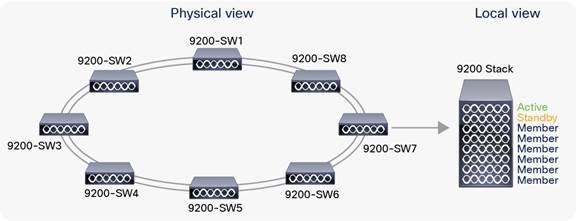
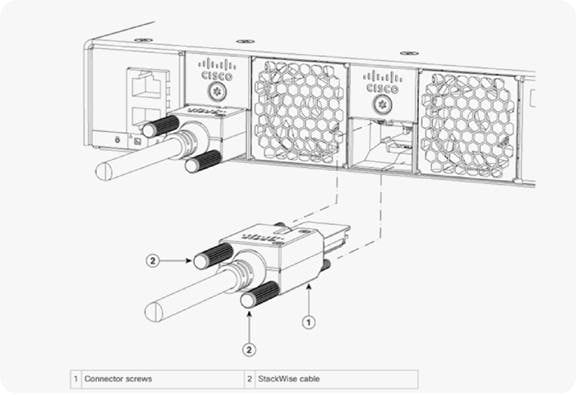

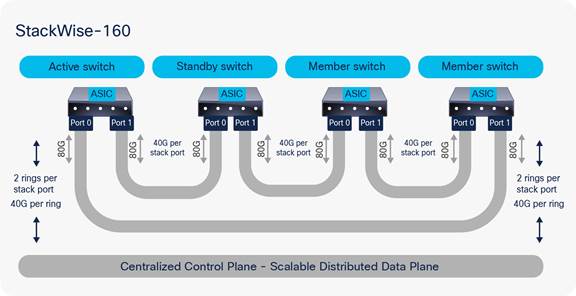
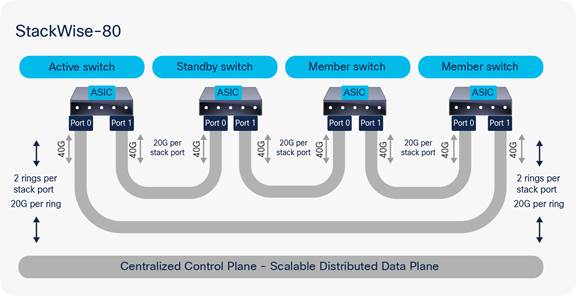
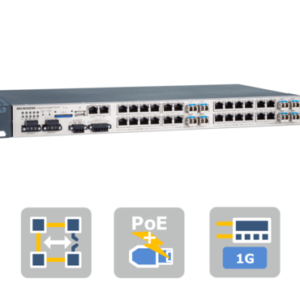
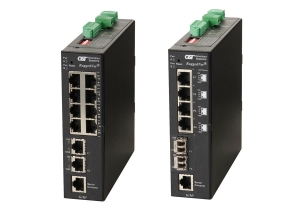
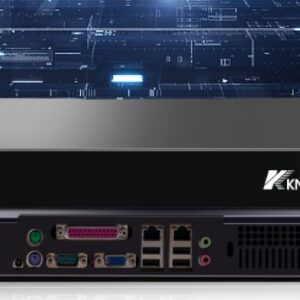
Reviews
There are no reviews yet.